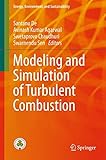Modeling and Simulation of Turbulent Combustion [electronic resource] / edited by Santanu De, Avinash Kumar Agarwal, Swetaprovo Chaudhuri, Swarnendu Sen.
Contributor(s): De, Santanu [editor.] | Agarwal, Avinash Kumar [editor.]
| Agarwal, Avinash Kumar [editor.] | Chaudhuri, Swetaprovo [editor.]
| Chaudhuri, Swetaprovo [editor.] | Sen, Swarnendu [editor.]
| Sen, Swarnendu [editor.] | SpringerLink (Online service)
| SpringerLink (Online service) .
.
Material type:  BookSeries: Energy, Environment, and Sustainability: Publisher: Singapore : Springer Nature Singapore : Imprint: Springer, 2018Edition: 1st ed. 2018.Description: XVIII, 661 p. 225 illus., 135 illus. in color. online resource.Content type: text Media type: computer Carrier type: online resourceISBN: 9789811074103.Subject(s): Thermodynamics
BookSeries: Energy, Environment, and Sustainability: Publisher: Singapore : Springer Nature Singapore : Imprint: Springer, 2018Edition: 1st ed. 2018.Description: XVIII, 661 p. 225 illus., 135 illus. in color. online resource.Content type: text Media type: computer Carrier type: online resourceISBN: 9789811074103.Subject(s): Thermodynamics1. Tentative Title of the Chapters -- 2. Fundamentals and modelling of Turbulence – Chemistry Interactions -- 3. Development of reaction mechanisms for combustion simulations -- 4. Optimization and reduction of chemical kinetics -- 5. Turbulent Combustion simulations with HPC -- 6. Direct Numerical Simulations of Turbulent Combustion -- 7. RANS of premixed turbulent flames -- 8. Large eddy simulations of turbulent premixed combustion -- 9. Modelling of Turbulent Premixed Flames using Flamelet-Generated Manifolds -- 10. Modelling of Turbulent Premixed Flames using Conditional Moment Closure -- 11. Direct Numerical Simulations of premixed turbulent combustion: Relevance and applications to engineering computational analyses -- 12. Conditional Moment Closure Methods for Turbulent Non-Premixed Combustion -- 13. Direct Numerical Simulations of autoignition in turbulent non-premixed flames -- 14. Soot modelling in hydrocarbon flames: assessment of semi-empirical models and method of moments -- 15. Transported PDF method for MILD combustion -- 16. Large eddy simulation of nonpremixed flames using filtered mass density function approach -- 17.Multiple Mapping Conditioning Approach -- 18. Characterization of turbulent combustion systems using dynamical systems theory -- 19. Modeling of soot formation in a kerosene spray flame -- 20. Modeling and Simulations of Turbulent Stratified Flames -- 21. Recent Progress in Turbulent Combustion Modeling of Spray Flames using Flamelet Models -- 22. Numerical simulation of turbulent combustion in internal combustion engines -- 23. On the Theory and Modelling of Flame Acceleration and Deflagration-to-Detonation Transition -- 24. Combustion in supersonic flows and scramjet combustion simulation. .
This book presents a comprehensive review of state-of-the-art models for turbulent combustion, with special emphasis on the theory, development and applications of combustion models in practical combustion systems. It simplifies the complex multi-scale and nonlinear interaction between chemistry and turbulence to allow a broader audience to understand the modeling and numerical simulations of turbulent combustion, which remains at the forefront of research due to its industrial relevance. Further, the book provides a holistic view by covering a diverse range of basic and advanced topics—from the fundamentals of turbulence–chemistry interactions, role of high-performance computing in combustion simulations, and optimization and reduction techniques for chemical kinetics, to state-of-the-art modeling strategies for turbulent premixed and nonpremixed combustion and their applications in engineering contexts. .


There are no comments for this item.